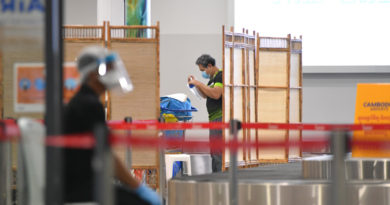DA NANG: APEC – AS-PAC OKAYS FREE TRADE WIHTOUT U.S.
POSE FOR POSTERITY. (front, from left) China’s President Xi Jinping, Vietnam’s President Tran Dai Quang, Indonesia’s President Joko Widodo; (back, from left) Philippine President Rodrigo Duterte, Russia’s President Vladimir Putin, and US President Donald Trump wave to the unseen crowd in this ‘family photo’ during the Asia-Pacific Economic Cooperation leaders’ summit in Da Nang Saturday. AFP
.
DA NANG, Vietnam—Ministers from 11 Asia-Pacific countries agreed Saturday to press ahead with a major trade deal without the United States, as the world’s largest economy seeks to go it alone under President Donald Trump’s “America First” policy.
Trump pulled his country from the Trans Pacific Partnership (TPP) at the start of the year, dismaying allies and casting into doubt an agreement heralded for tying lower tariffs to strong environmental and labor protections.
He has been something of a lone protectionist voice at the Apec summit in this city where world leaders, including China’s Xi Jinping, have been keen to promote the virtues of free trade and multilateral deals.
.
.
“The common interests of Apec and Asean means that we can take ideas one step further to give birth to collaborative models using hard infrastructure,” Duterte said in milestone informal dialogues between leaders of the Apec and the Association of Southeast Asian Nations.
“Similar to the Manila-Acapulco Galleon Trade that leveraged the central position of the Philippines in the Asia-Pacific region, Asean can be a hub for the Asia-Pacific region in relevant areas,” he added.
Asean builds a political, economic, and social community through negotiated norms and binding agreements, while Apec is an incubator of ideas and acts through voluntary commitments and initiatives.
Duterte noted that Asean and Apec have different methods when it came to trade.
“I see two initial ways that Asean strengthens Apec. Inspired by Apec’s model of open regionalism, Asean has opened the door wider to the eventual achievement of liberalized trade in Asia and the Pacific.”
He said: “Collaborating with Apec on common areas of interest, Asean can potentially play the role of a regional pathfinder for Apec’s initiatives.
“Asean can also serve as Apec’s institutional memory and provide consistency to Apec’s role as an incubator of ideas and driver of regional economic growth and integration.”
Apec’s pioneering success in securing voluntary commitment to the Environmental Goods List prior to any binding agreement in the World Trade Organization “demonstrates a way forward for effective international decision-making,” Duterte added.
Among areas of cooperation between Asean and Apec includes digital and maritime connectivity, efficient logistics, disaster preparedness and management, technology, MSMEs and inclusive growth, Duterte said. “An integrated region like Asean, which has developed the tools to achieve this, is a good place to start.”
This year, Asean celebrates 50 years of its establishment while Apec is gearing up for its 30th anniversary in 2019 and is preparing to undertake a visioning exercise towards 2020 and beyond.
Seven Asean members—Brunei, Indonesia, Philippines, Malaysia, Singapore, Thailand, and Vietnam—are part of the Apec, alongside some of the world’s largest economies such as the United States, China, Japan, Russia and Canada.
With the informal dialogues, it will be the first time that Cambodia, Laos, and Myanmar join discussions in the Apec.
In a joint statement Saturday morning, the remaining countries—dubbed the TPP-11—said they had “agreed on the core elements” of a deal at the sidelines of the Apec summit in the Vietnamese city of Danang, after days of stalled talks raised fears it could collapse altogether.
The ministers said further talks would be needed to reach a full consensus before inking the deal, which now carries an even longer official name—the Comprehensive and Progressive Agreement for Trans-Pacific Partnership (CPTPP).
Japan’s lead negotiator Toshimitsu Motegi said the remaining members would still welcome the United States back into their pact.
“This time all the 11 countries are on board and this would send out a very strong positive message to the United States and other Asia Pacific countries in the region,” he said.
Francois-Philippe Champagne, Canada’s trade minister, described the breakthrough in a tweet as “big progress.”
Canada had held out to maintain environmental and labor protections linked to freer markets in the deal.
Those elements were thrown into jeopardy by America’s sudden withdrawal from the deal earlier this year.
Canada had dug in over those progressive clauses. But they are much less attractive to countries like Vietnam, Malaysia, Chile and Peru now that the carrot of access to the huge US market has been pulled.
Upended consensus
Trump’s election has upended years of American-led moves to open up global trade.
The US president is among leaders attending the Apec summit in Da Nang and on Friday he ladled out more of his trademark “America First” rhetoric.
In a strident address he said his country will “no longer tolerate” unfair trade, closed markets and intellectual property theft.
“We are not going to let the United States be taken advantage of any more,” he added, taking a swipe at multilateral trade deals. AFP, John Paolo Bencito
Shortly after, China’s Xi offered a starkly different vision, casting his country as the new global leader for free trade.
Beijing is not included in the TPP, a deal initially driven through by the former US administration as a counterweight to surging Chinese power in Asia.
China has since sought to fill the free trade gap left by the United States, even if much of its own market remains protected.
Japan, the world’s third largest economy, has been particularly active in pushing for a swift consensus on TPP, fearful that delays could lead to the collapse of the pact after years of negotiations and hand more regional influence to China.
But Canada has pushed back against a quick fix.
“This is about setting the terms of trade for generations,” a Canadian delegation source told AFP.
Analysts say the provisional deal reached in Da Nang will breath new life into global free trade deals at a time when the United States is turning its back on them.
Deborah Elms, executive director of the Asian Trade Centre, told AFP that even without the US, TPP-11 is “the most important trade agreement signed in the last 20 years”.
“Companies had largely given up on the TPP after the withdrawal of the United States,” she said. “Now firms will need to scramble to figure out how the agreement matters to their business.”
At the Apec summit on Saturday, Trump faced a long day of meetings with world leaders who are all pushing for more open trade.
As well as Xi, Russia’s Vladimir Putin, Japan’s Shinzo Abe and Canada’s Justin Trudeau are among those attending.
The original TPP deal was once described by the US as a “gold standard” for all free trade agreements because it went far beyond just cutting tariffs.
It included removing a slew of non-tariff restrictions and required members to comply with a high level of regulatory standards in areas like labor law, environmental protection, intellectual property and government procurement.
Without the US, TPP-11 only represents 13.5 percent of the global economy but the remaining countries are scrambling to avoid the deal’s collapse, especially given the increasingly protectionist winds sweeping through the United States and Europe. AFP
<>
NOTE : All photographs, news, editorials, opinions, information, data, others have been taken from the Internet ..aseanews.net | [email protected] |
For comments, Email to :
Aseanews.Net | [email protected] | Contributor









